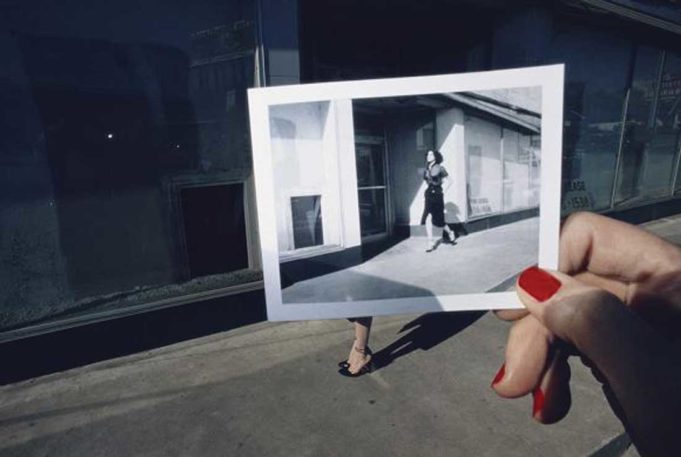The Polaroid Project: At the Intersection of Art and Technology provides a glorious blend of pop culture, photography, and science.
The idea for the Polaroid camera was literally child’s play. Edwin Land, a physicist who dropped out of Harvard University, cofounded the Polaroid Corporation prior to World War II. When Land’s daughter Jennifer asked him why she couldn’t immediately see the picture taken on film from a traditional camera, Land, as the story goes, drew out a prototype of the technology needed for what would become the Polaroid camera within an hour. The Amon Carter Museum of American Art’s current exhibition chronicles Land’s innovation, from drawing to prototype to product to the art created with his invention over the mid-20th century.
These days, with our phone cameras and our GoPros, Land’s technology seems charmingly obsolete. But a majority of us Gen Xers had a Polaroid camera in the heady 1970s and early ’80s – perhaps the SX-70, a 600 type, or maybe the Barbie version. Prior to inventing the instant camera, Land worked with the U.S. military on more advanced versions of night vision goggles, and he developed a film capable of polarizing light – hence the name Polaroid. After tinkering with his daughter’s request for a camera that included a darkroom in the film so the user could peel the negative from the picture, Land’s initial offering (the Land Camera) at a single Boston department store sold out around Christmastime in 1948. By 1965, the aptly-named Swinger camera became an affordable, portable way to shoot in black and white. In the ’70s, Land developed the SX-70 film and camera, allowing instant pictorial gratification in color. No offense to Outkast, but we were never meant to shake our Polaroid pictures as they developed.
In addition to newer and better prototypes of his personal cameras, Land also produced giant studio versions that generated 20-by-24-inch prints, and he would give well-known photographers like Ansel Adams and Andy Warhol access to these cameras – asking only for a few prints of the series as payment. Three decades’ worth of art was collected and displayed at the company’s headquarters. Sadly, the digital revolution eclipsed Polaroid technology in the early part of this century, and the collection was split and parceled off for sale during Polaroid’s bankruptcy in 2010.
The exhibit at the Amon Carter Museum plumbs this history, and it’s a fascinating mixture of both the science behind the technology and the results of its use. Much of the art from 100 artists spread over several decades is exhilarating and inspiring, and it doesn’t look like the classic Polaroid or sometimes even a photograph. John Reuter’s “The Magician,” Ulrich Mack’s “Agave American Marginata,” and Jo Whaley’s “Atomic Tea Party” look like paintings.
A few of the pieces hew to the traditional 3.5-by-4.25-inch frame. One of Warhol’s contributions, “Shoes,” is nothing more than a classic Polaroid of eight mismatched Halston heels. In others, like “Untitled #4,” Joyce Niemans uses more than 200 traditionally sized Polaroid photos to create a mosaic. In her artist statement in the accompanying book, Niemans said that “by using color, lines, and shapes from any object,” she could “paint a picture using Polaroid photographs.”
In the magnificent “Serpent Green Reclining Nude,” Lucas Samaras combines 30 Polaroids overlapping one another to create the image of a nude man on a couch. To complete “The Red and the Black,” Barbara Crane assembled 127 red and black images, generating an eerie shadow effect. Crane credited the film technology for providing “immediate feedback to transform my own vision.”
Although the company was disbanded as part of the bankruptcy in 2010, interest in the camera never completely died. Thanks to a group called the Impossible Project, which bought one of the last Polaroid factories in the dying days of 2008, if you have a functional camera, they’ll sell you some film packs. If you want to buy a 2017-era Polaroid-like camera (they can’t use the company’s name), they’ll sell you one of those, too. The technology has progressed to the point of linking the camera on your phone with an app-driven I-1 analog camera that prints out your picture from packs of instant film.
After its stint in Fort Worth (its only Texas stop), The Polaroid Project: At the Intersection of Art and Technology will travel to museums in Vienna, Montreal, and Cambridge, Mass.
The Polaroid Project: At the Intersection of Art and Technology
Thru Sep 3 at the Amon Carter Museum of American Art, 3501 Camp Bowie Blvd, FW. Free. 817-738-1933.












